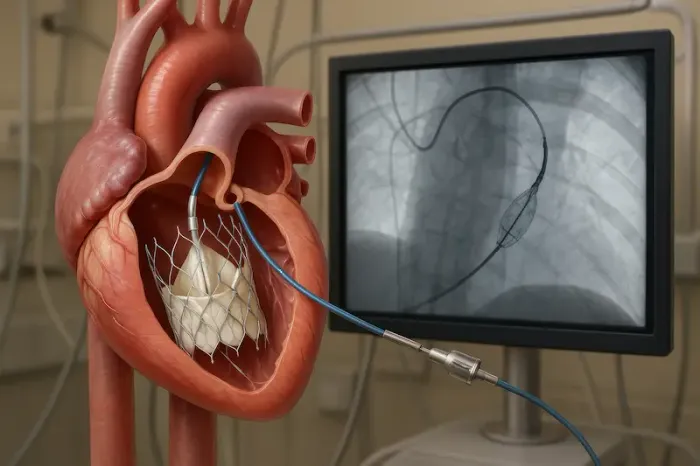TAVI Explained Benefits, Risks, and Recovery
Learn about TAVI, a minimally invasive heart procedure. Explore its benefits, potential risks, and what to expect during recovery.

Written by Dr. Siri Nallapu
Reviewed by Dr. D Bhanu Prakash MBBS, AFIH, Advanced certificate in critical care medicine, Fellowship in critical care medicine
Last updated on 25th Sep, 2025

Introduction
For decades, treating a severely narrowed aortic valve, a condition called aortic stenosis, meant undergoing open-heart surgery. While effective, this procedure involves a large chest incision, stopping the heart, and a long, challenging recovery. Today, a revolutionary alternative has transformed care for millions: Transcatheter Aortic Valve Implantation, or TAVI (also known as TAVR). This minimally invasive procedure offers new hope, especially for patients considered too high-risk for traditional surgery. But what does it really entail? This comprehensive guide will walk you through everything you need to know about the TAVI procedure, from its profound benefits and potential risks to the detailed recovery journey, empowering you with the knowledge to have an informed discussion with your cardiologist.
What is TAVI? Understanding the Procedure
Transcatheter Aortic Valve Implantation (TAVI) is a minimally invasive procedure used to replace a diseased aortic valve without the need for open-heart surgery. Instead of a large chest incision, the surgeon inserts a catheter (a thin, flexible tube) through a small access point, typically in the groin (femoral artery). A collapsible replacement valve is mounted on this catheter and guided through the blood vessels to the heart. Once in position, the new valve is expanded, pushing the old, diseased valve leaflets aside and immediately taking over the function of regulating blood flow out of the heart.
TAVI vs. Open-Heart Surgery: Key Differences
The fundamental difference lies in the level of invasion. Open-heart surgery (SAVR - Surgical Aortic Valve Replacement) requires a sternotomy (cutting through the breastbone), connecting the patient to a heart-lung machine, and stopping the heart during the operation. TAVI, as a minimally invasive heart surgery, avoids this. Key differences include:
• Incision: TAVI uses a small puncture; SAVR uses a 6-8 inch incision.
• Anesthesia: TAVI is often performed under light sedation or local anesthesia; SAVR requires general anesthesia.
• Heart-Lung Bypass: TAVI does not require it; SAVR does.
• Recovery Time: This is significantly shorter with TAVI.
The Aortic Valve and Aortic Stenosis: The Problem TAVI Solves
The aortic valve is the main exit valve from your heart, controlling blood flow to the rest of your body. Aortic stenosis occurs when this valve narrows, often due to calcium buildup over time (degenerative stenosis). This forces the heart to work much harder to pump blood, leading to symptoms like severe shortness of breath, chest pain, dizziness, and fainting. If left untreated, severe aortic stenosis has a very poor prognosis. The TAVI procedure success rate in alleviating these symptoms is exceptionally high.
Consult a Cardiologist for the best advice
Who is a Candidate for TAVI?
Initially, TAVI was approved only for patients deemed inoperable or at extremely high surgical risk. However, as evidence of its safety and efficacy has grown, its approval has expanded.
Ideal Candidates: From High-Risk to Intermediate-Risk Patients
Today, TAVI is a standard option for virtually all patients with severe symptomatic aortic stenosis who are over 65-70 years old, including those at low, intermediate, and high surgical risk. The decision is made by a "Heart Team," a collaborative group of cardiologists, cardiac surgeons, and other specialists who evaluate each patient individually. Factors considered include age, overall health, the specific anatomy of the heart and blood vessels, and patient preference.
The Pre-Procedure Evaluation: Tests to Determine Eligibility
Before approving a patient for TAVI, a thorough assessment is conducted. This typically includes an echocardiogram (ultrasound of the heart) to confirm the severity of stenosis, a CT angiogram to map the blood vessels and determine the correct valve size, and various blood tests. If you experience symptoms like shortness of breath, consulting a cardiologist via Apollo24|7 can be the first step toward a formal evaluation.
The Significant Benefits of Choosing TAVI
The advantages of the TAVI procedure are substantial and have made it the preferred choice for a majority of eligible patients.
Minimally Invasive Approach: Smaller Incisions, Less Trauma
As a catheter-based procedure, TAVI avoids the trauma of cracking the chest. This translates to significantly less pain, lower risk of infection, and no large surgical scar.
Faster Recovery and Shorter Hospital Stays
While open-heart surgery often requires a week or more in the hospital followed by months of recovery, the TAVI recovery time is dramatically shorter. Many patients are discharged within 1-3 days and can return to light activities within a week or two.
A Viable Option for High-Risk Surgical Patients
For elderly patients or those with multiple co-existing conditions (like lung or kidney disease), open-heart surgery may be prohibitively risky. TAVI offers these individuals a life-saving treatment option they otherwise would not have.
Improved Quality of Life and Symptom Relief
The primary goal of TAVI is to relieve the debilitating symptoms of aortic stenosis. Patients often report a dramatic improvement in their ability to breathe, walk, and engage in daily activities, leading to a significantly enhanced quality of life.
Understanding the Potential Risks and Complications of TAVI
While TAVI is safer than open-heart surgery for many, it is still a major heart procedure and carries potential risks. It's crucial to understand these.
Common, Less-Serious Risks
• Bleeding or Bruising: At the catheter insertion site.
• Blood Vessel Injury: Minor damage to the artery used for access.
• Arrhythmia: Temporary irregular heartbeats.
Serious but Less Common Complications
While rare, some complications of TAVI can be serious and require careful monitoring and prompt medical attention.
Vascular Complications
Involves significant damage to the major blood vessels used for access, which may require surgical repair.
Stroke and TIA (Transient Ischemic Attack)
During the procedure, plaque or debris can dislodge and travel to the brain, causing a stroke. The risk is low (approximately 1-2%) and surgeons use cerebral embolic protection devices in some cases to minimise it.
Heart Block and the Need for a Pacemaker
The new valve's pressure on the heart's electrical system can cause a condition called heart block, where the heartbeat becomes too slow. This is one of the more common TAVI complications, occurring in about 10-15% of patients, necessitating the implantation of a permanent pacemaker.
Paravalvular Leak
This occurs if the new valve doesn't form a perfect seal with the native tissue, allowing blood to leak around it. Most leaks are minor, but significant leaks can affect the valve's performance and long-term durability.
The TAVI Recovery Journey: What to Expect
Knowing what to expect can ease anxiety and promote a smoother healing process.
Hospital Stay (Typically 1-3 Days)
After the procedure, you'll be monitored closely in a recovery unit. Most patients spend one night in the ICU and are moved to a regular room the next day. You'll be encouraged to sit up and walk with assistance very soon after.
The First Week at Home: Activity and Wound Care
The TAVI recovery time at home involves taking it easy. Focus on keeping the access site clean and dry. Avoid heavy lifting (nothing over 10 pounds) and strenuous activities. Short, gentle walks are encouraged. If you notice increased redness, swelling, or drainage from the wound site, it's important to consult your doctor immediately. You can connect with a specialist online through Apollo24|7 for a quick assessment.
Long-Term Recovery: Cardiac Rehabilitation and Lifestyle
Many patients are referred to cardiac rehab, a supervised program of exercise and education to safely rebuild strength and heart health. Adhering to prescribed medications, like blood thinners, and attending all follow-up appointments is critical.
Life After TAVI: Long-Term Outlook and Care
Understanding life after TAVI helps patients manage their heart health and maintain a good quality of life in the long term.
Medication and Follow-Up Appointments
You will likely need to take medications, such as antiplatelets, to prevent blood clots from forming on the new valve. Regular follow-ups with echocardiograms are essential to monitor the valve's function.
Monitoring Your Valve's Health
The long-term durability of TAVI valves is excellent, with studies showing they last well beyond 10 years. Ongoing monitoring ensures any potential issues, like late-onset leaks or structural changes, are caught early.
Conclusion: Empowering Your Decision for a Healthier Heart
The development of TAVI represents a monumental leap forward in cardiac care, offering a safer, less traumatic path to treating a life-threatening condition. While understanding the risks is a vital part of the process, the profound benefits, including a rapid recovery and restored quality of life, make it a compelling option for most patients with severe aortic stenosis. If you or a loved one is facing this diagnosis, have a detailed conversation with your healthcare team. Ask about your suitability for TAVI, the specific risks in your case, and the expected recovery pathway. Being informed is the first step toward reclaiming your health and vitality.
Consult a Cardiologist for the best advice
Consult a Cardiologist for the best advice

Dr. Lal Daga
Cardiologist
20 Years • MBBS, DNB [MED], DNB [CARDIO], FESC [INT], MNAMS
Ahmedabad
Apollo Hospitals Gandhinagar, Ahmedabad

Dr. Dayanashre N
General Physician
3 Years • MBBS
Bengaluru
PRESTIGE SHANTHINIKETAN - SOCIETY CLINIC, Bengaluru

Dr. Sushith C
General Physician
2 Years • MBBS
Bengaluru
PRESTIGE SHANTHINIKETAN - SOCIETY CLINIC, Bengaluru

Dr. Bhethala Sharan Prakash
General Physician/ Internal Medicine Specialist
5 Years • MBBS MD
Bengaluru
PRESTIGE SHANTHINIKETAN - SOCIETY CLINIC, Bengaluru

Dr. Zulkarnain
General Physician
2 Years • MBBS, PGDM, FFM
Bengaluru
PRESTIGE SHANTHINIKETAN - SOCIETY CLINIC, Bengaluru
Consult a Cardiologist for the best advice

Dr. Lal Daga
Cardiologist
20 Years • MBBS, DNB [MED], DNB [CARDIO], FESC [INT], MNAMS
Ahmedabad
Apollo Hospitals Gandhinagar, Ahmedabad

Dr. Dayanashre N
General Physician
3 Years • MBBS
Bengaluru
PRESTIGE SHANTHINIKETAN - SOCIETY CLINIC, Bengaluru

Dr. Sushith C
General Physician
2 Years • MBBS
Bengaluru
PRESTIGE SHANTHINIKETAN - SOCIETY CLINIC, Bengaluru

Dr. Bhethala Sharan Prakash
General Physician/ Internal Medicine Specialist
5 Years • MBBS MD
Bengaluru
PRESTIGE SHANTHINIKETAN - SOCIETY CLINIC, Bengaluru

Dr. Zulkarnain
General Physician
2 Years • MBBS, PGDM, FFM
Bengaluru
PRESTIGE SHANTHINIKETAN - SOCIETY CLINIC, Bengaluru
More articles from Heart disease
Frequently Asked Questions
1. What is the life expectancy after a TAVI procedure?
Life expectancy after TAVI is excellent and primarily depends on the patient's age and overall health condition at the time of the procedure. For many patients, especially the elderly, TAVI restores a life expectancy similar to that of their healthy peers without aortic stenosis. The procedure is considered a durable, long-term solution.
2. Is TAVI considered a major surgery?
Yes, TAVI is a major heart procedure because it involves replacing a critical heart valve. However, it is 'minimally invasive' compared to traditional open-heart surgery. It does not require a large chest incision or stopping the heart, which significantly reduces the physical trauma to the body.
3. What are the restrictions after TAVI?
For the first few weeks, you should avoid driving, heavy lifting, and strenuous exercise. Your care team will provide specific guidelines on when you can resume these activities. Long-term, you will need to take certain medications and attend regular follow-up appointments to monitor the new valve.
4. How long does a TAVI valve last?
Current data shows that TAVI valves are very durable. Studies following patients for over 8-10 years indicate that the valves continue to function well without significant deterioration. Long-term data is still being collected, but the outlook is very positive.
5. Can TAVI be done more than once?
In some cases, yes. If a TAVI valve wears out after many years, a second TAVI procedure (called a 'valve-in-valve' implantation) can often be performed inside the first one. This is a complex decision made by the Heart Team based on the patient's anatomy and health.

